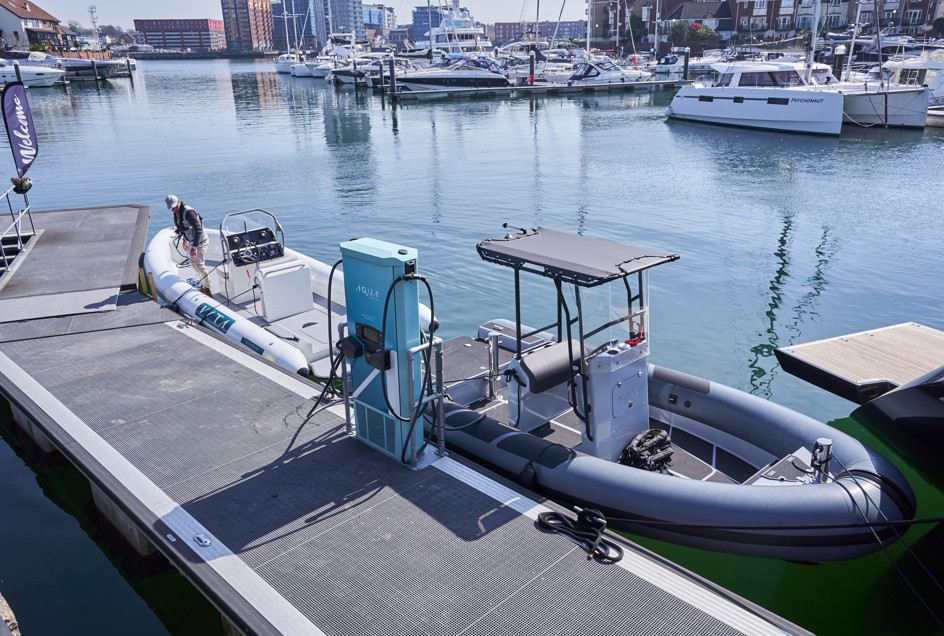Aqua superPower Drives The Electric Seaway to Success, Powering Sustainable Marine Travel on the UK’s South Coast

Southampton, UK, 15thApril 2025 – Aqua superPower, in collaboration with its consortium partners, announces the successful demonstration of The Electric Seaway project, a transformative initiative that delivers critical marine charging infrastructure along the south coast of the UK. Launched in June 2023 with £3.2 million in funding from the UK Shipping Office for Reducing Emissions (UK SHORE) programme in the Department for Transport, with Innovate UK as the main delivery partnerhis pioneering project has established eight new charging sites, creating a robust network to support the region’s growing fleet of electric maritime vessels.
The Electric Seaway has achieved its ambitious goal of enabling leisure and commercial vessels under 24m to transition to clean energy, bolstering the UK’s Maritime 2050 decarbonisation targets. Over the course of the project, this infrastructure is projected to prevent significant CO2 emissions, an important step forward in reducing the environmental impact of marine activity along the south coast.
The Electric Seaway locations include MDL Ocean Village, Isle of Wight Trinity Landing featuring two chargers, and Fowey, equipped with two chargers—one supported by an innovative ZPN battery backup. Expanding the Aqua network, additional fast-charging marine sites now encompass Lymington, Chichester Itchenor, and Falmouth, reinforcing The Electric Seaway’s commitment to sustainable and efficient maritime energy solutions.
Led by Aqua superPower and ZPN Energy, alongside key partners including the University of Plymouth, South Hams District Council, Bournemouth, Poole and Christchurch Council, and the UK Harbour Masters’ Association, the project has deployed innovative battery-backed ultra-rapid charging technology tailored for shoreside applications. This solution overcomes grid limitations in coastal areas, ensuring reliable and efficient charging for electric boating areas with limited grid capacity. Environmental sensors installed at all charging sites by the University of Plymouth provide valuable data, confirming the positive environmental impact of this shift to cleaner marine travel.
The completion of The Electric Seaway builds on the legacy of the Marine eCharging Living Lab (MeLL) project, expanding the UK’s first marine charging network into a scalable model with global potential. The initiative has not only delivered on its technical objectives but also fostered economic growth, supporting a burgeoning cluster of low-carbon marine businesses, creating new jobs, and positioning the UK as a leader in the electric boat and charging sectors.
The Electric Seaway has proven to be a groundbreaking initiative, driving innovation and yielding valuable insights for its diverse consortium of partners. The project has pioneered solutions for deploying marine charging infrastructure in areas with limited grid connections, utilising advanced battery storage and renewable energy integration to overcome logistical challenges. Partners like ZPN Energy have refined processes for efficient site delivery, ensuring scalable and practical deployment of charging stations along the UK’s south coast. The University of Plymouth has spearheaded ongoing environmental data collection, employing sensors to monitor ecological impacts and inform future decarbonisation strategies. Meanwhile, Aqua superPower has introduced a new compatibility service, enhancing interoperability between charging systems and electric vessels. These learnings are set to shape future projects, advancing the transition to clean maritime solutions and reinforcing the consortium’s leadership in sustainable innovation.
Karen Gill, COO of Aqua superPower, said: “The Electric Seaway has been a resounding success, delivering on our vision to create a reliable and accessible charging network for electric vessels. This project showcases the power of collaboration and innovation in driving the decarbonisation of the maritime sector. We’re thrilled to see the south coast emerge as a hub for sustainable marine travel, offering both commercial operators and leisure users the confidence to embrace electric propulsion. The Electric Seaway is one of many projects demonstrating and showcasing their project and technology around the UK in 2025, involving a variety of vessel types and new infrastructure in ports and harbours.”
James Foster, CEO of ZPN Energy, added: “Our battery-backed charging technology has proven its value in overcoming infrastructure challenges, ensuring rapid charging even in areas with limited grid capacity. The project provided valuable learning around third party chargers, allowing access to a retrofit model. Completing The Electric Seaway is a milestone for us and a testament to how public investment in innovation can deliver real-world impact.”
Dr Simon Ussher, Associate Professor of Marine and Analytical Chemistry at the University of Plymouth reflected on the project’s significance: “The Electric Seaway has demonstrated how research, industry, and local stakeholders can work together to tackle the complex challenges of maritime decarbonisation. The data and insights we’ve gathered will inform future efforts, ensuring the transition to zero-emission fleets accelerates inline with the 2050 goals.”
Capt Martin Willis AFNI, Executive Officer & Secretary of the UK Harbour Masters’ Association, commented: “This project aligns perfectly with our strategy to support sustainable maritime practices and alternative fuels. The Electric Seaway has laid the groundwork for a cleaner, greener future for UK ports, and we’re proud to have played a role in its success.”
South Hams District Council, a key partner, has embraced the project which is helping them to work towards a cleaner marine environment across the South Hams. The Council is engaging with its local marine industry and boat users to encourage the transition to electric propulsion and open up opportunities in the low-carbon marine sector.
Bournemouth, Poole, and Christchurch Council (BCP), a vital partner and stakeholder, has seamlessly incorporated The Electric Seaway into its ambitious carbon reduction strategy. Recognising its value, BCP views The Electric Seaway as a cornerstone in bolstering the local maritime industry. With its pioneering approach, The Electric Seaway continues to set the standard for innovation in sustainable marine solutions.
With its innovative business model and proven technology, The Electric Seaway is poised to serve as a blueprint for marine charging infrastructure worldwide. As the UK establishes itself as a ‘first-mover’ in this space, the project’s legacy will extend far beyond the south coast, supporting global efforts to decarbonise maritime transport and inspiring further investment in sustainable solutions.
